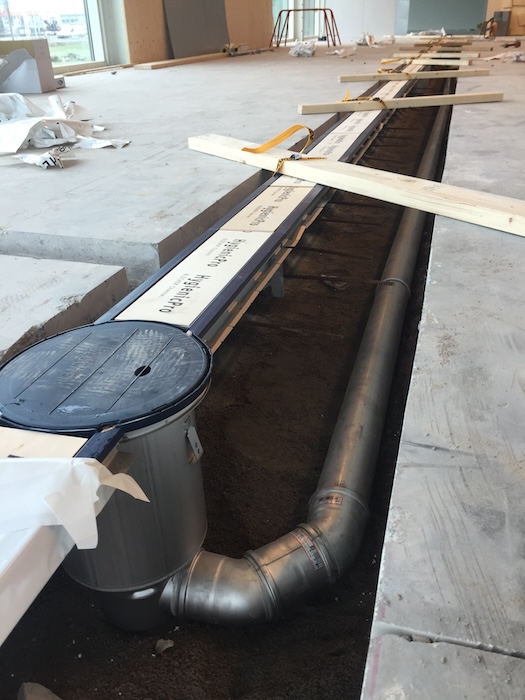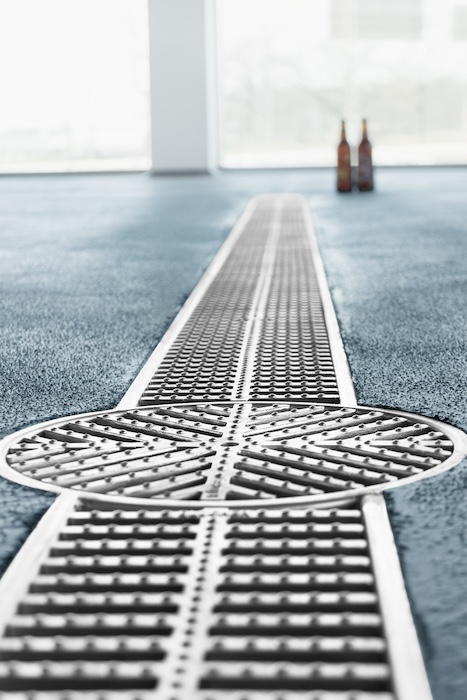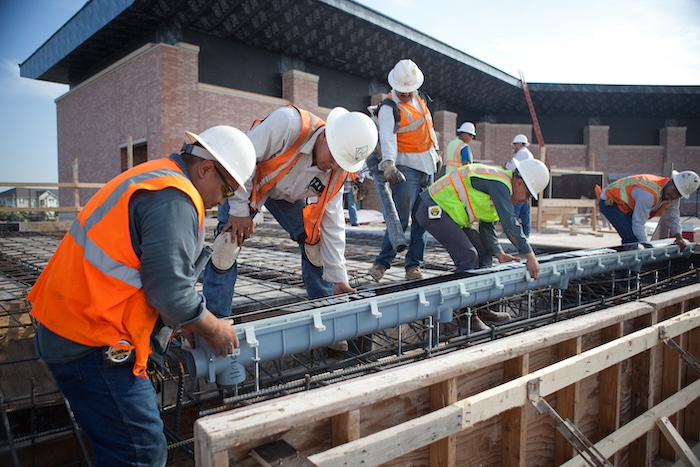
The versatility of trench drains
April 16, 2024
By John Vastyan
There is more to them than meets the eye.
Every building foundation begins with the certainty that drainage will be needed to control or reduce water runoff or for the intentional eliminating of fluids generated within the structure. Yet, in something of an anomaly, trench drains are one of the very last considerations among building systems, even though they are first to go in.
Drains come in many shapes, designs and sizes, all based on use and intent, both indoors and out. The trench drain is one of the most effective means of assuring proper drainage, especially when higher volumes of fluids are involved.
There are two primary reasons to specify trench drains:
1. Faster removal of surface water.
In courtyards, amphitheatres, sports complexes and other high-traffic areas, rainwater needs to drain quickly to avoid ponding, which can be a nuisance and a safety hazard.
2. Reduce travel distance to a drainage point.
For indoor applications, such as auto dealerships, sanitary manufacturing plants, breweries, distribution facilities and other business that wash floors daily, this is an important consideration. Directing daily wash-downs to a line of trench drain is an efficient way to keep floors sanitary and safe.
A history of drainage
Trench drains made their debut with poured keyways. In these applications, concrete is formed into a channel with a ledge (hence, ‘keyway’) to support the grating. Formed concrete channels deteriorate over time, however. Heavy traffic causes the ledge supporting the grating to chip, making the grates unstable.
Next came polymer concrete trench drains. Their manufactured channels eliminate the need for field-forming and offer high compressive strength, making them very durable—but the material is very heavy and difficult to work with. Aligning, levelling and stabilizing are time-consuming and expensive.
Trench drains made their debut with poured keyways.
Composite plastic trench drains came next. Early versions offered some advantages, as they were light and easier to handle than polymer concrete, but because the plastic lacked compressive strength and structural stability, heavy traffic caused stress and, thus, channels deformed and separated from the surrounding concrete.
Today, composite plastic trench drains have come a long way since their introduction. They are available in many sizes, shapes and designs and can be used for both indoors (microbrewery managers, for example, have learned trench drains are an ideal companion to large, interior containers that require regular washing) and outdoors for surface drainage of everything from residential driveways to the world’s busiest airports.
Trench drains may be a single foot to thousands of feet long. They may drain to a single point or at many connected points along the length of an extended system.
“There’s little question trench drain technology has come a long way,” says Roy Hetzler, product specialist at Watts. “In one of the latest developments, engineers have married the compressive strength and long-term performance of polymer concrete trench drains with the ease of handling and installing plastic trench drains.”

Trench drains are one of the last considerations among building systems, even though they are first to go in. Photo courtesy Watts.
Drain specifics
Standard commercial-grade trench drain systems are pre-sloped, typically at a grade of 0.7%. While a sloped trench drain system is occasionally required to increase flow velocity, the slope primarily assists with flushing, helping to carry debris and keeping the channel clean. This is a critical feature in areas where organic debris can accumulate and create health hazards, such as animal shelters, food manufacturing facilities and pool decks.
Common trench drain systems have a nominal width of either 6 or 12 in., although others are available. For indoor applications, 6 in. is typically sufficient where drains are primarily used for floor washing. Outdoor installations receiving rainwater runoff may require a wider trench drain. Those positioned at the bottom of loading ramps and similar sloped areas will receive large flows.
Trench drain gratings are chosen to accommodate anticipated traffic. Heavy vehicles with small wheels (e.g. forklifts and construction equipment) and those traveling at high rates of speed (e.g. airplanes and roadway traffic) create the heaviest loads.
In areas with pedestrian traffic, designers often specify grating with smaller openings to ensure safety for all users. In the U.S., compliance with the Americans with Disabilities Act calls for maximum 0.5-in. wide slots perpendicular to traffic flow, but many heel-proof grates feature 0.3-in. wide slots or smaller.
Material matters
Cast or ductile iron grating is commonly used in unfinished areas with heavy traffic, such as warehouses and vehicle service facilities. Iron grating shows rust after time, but the rust is purely cosmetic and does not negatively impact strength or durability.
Grates made of stainless steel prevent the growth of bacteria, so that material is often used for sanitary purposes in food manufacturing and service facilities.
Polypropylene (PP) grating is an optimal choice for animal shelters, pet care facilities and barefoot traffic around swimming pools, where metal would not be desired.
Composite plastic, as mentioned earlier, is light and easier to handle than polymer concrete. PP and high-density polyethylene (HDPE) plastics are most commonly used and their properties are interchangeable for the majority of applications.
As plastic lacks compressive strength, channel design is important. Heavy traffic can stress channels, causing them to misalign and eventually separate from the surrounding concrete.

For breweries and other indoor facilities, directing daily wash-downs to a line of trench drain is an efficient way to keep floors sanitary and safe. Photo courtesy Watts.
Applications in action
Toronto-based auto dealership Thorncrest Ford recently built a new service garage to expand its business. The 3,000-sf double-bay garage accommodates a customer reception centre and up to eight vehicles.
The plumbing and mechanical contractor relied on a trench drain system that married the compressive strength and long-term performance of polymer concrete with the ease of handling of plastic. The system is designed around the structural frame, not around a plastic channel, so the load is transferred to the concrete as intended.
As a result, the service garage can accommodate any size of vehicle without worry of the drains breaking under the weight. Further, the drains easily keep up with all of the snow and slush that comes in.
By way of comparison, MadTree Brewery in Cincinnati, Ohio, chose to install stainless steel trench drains in its new 50,000-sf brewhouse. These drains are designed specifically for use in the food and beverage industry, where hygiene is critical. They lack corners or inside cavities that could otherwise harbour bacterial growth.
In their old facility, MadTree’s employees would spend 10 to 15 minutes hosing down the floor after a tank cleaning to get all of the solids down the drain. With the new stainless steel drains, most of the solids make their way down the drain with little effort, so an employee only needs to spend a minute or so cleaning up any loose ends.
Floor and drain washing is required twice a day at the brewing facility. The new drains free up half an hour of labour and save hundreds of gallons of water each day. Over a year’s time, the savings are significant. The brewery is enjoying a strong return on investment (ROI).
“The design and engineering of the drains made them stand out,” says Mike Stuart, MadTree’s director of people and social strategies. “They proved to easily evacuate any waste going down the drain and used way less water in doing so.”
“Engineers have married compressive strength and long-term performance with ease of handling and installation.” – Roy Hetzler, Watts
Achieving balance
While use and function are always among the first considerations for trench drains, selection can be influenced by various trades and professionals.
“Specifying engineers are sure to scrutinize structural stability and long-term performance,” says Watts’ Hetzler. “Contractors, on the other hand, require functionality and uneventful installations, while building owners are concerned with the finished product’s appealing appearance, durability and ease of maintenance and use. Contemporary trench drains must meet a lot of very different needs and scrutiny.”
Then there are the wholesale distributors. With trench drains, they are looking for simplicity of ordering and stocking. Lighter products offer an advantage, but must still be durable and easy to install, so as to meet other functional expectations.
“Labour can be triple the material cost,” says Hetzler, “which is why east of installation can be the make-or-break point for the contractor. Obviously, that depends on the products specified by engineers.”
John Vastyan owns Common Ground, a trade communications firm based in Manheim, Penn., and represents Watts. For more information, visit www.watts.com.
This article originally appeared in the March/April 2024 issue of Canadian Consulting Engineer.
